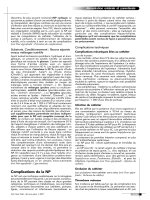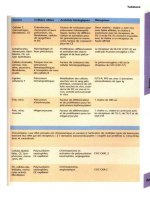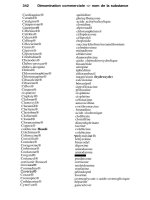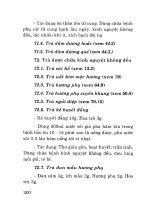Pocket Emergency Paediatric Care - part 10 pptx
Bạn đang xem bản rút gọn của tài liệu. Xem và tải ngay bản đầy đủ của tài liệu tại đây (137.76 KB, 20 trang )
184 POCKET EMERGENCY PAEDIATRIC CARE
• Following acute severe blood loss when 20–30% of the total
blood volume of 80 ml/kg is lost and bleeding is
continuing – remember Hb can initially be normal
Acute blood loss
Give 10–20 ml/kg of whole blood through wide bore cannula
or central venous line.
Estimate infusion rate for continuing transfusion using:-
• an estimate of blood lost
• an estimate of continuing loss
• vital signs
Top-up Transfusion for severe anaemia
WHOLE BLOOD: 20 ml/kg (increases Hb by 25% as
blood volume 80 ml/kg) or
required volume (ml) = weight (kg) ×
4 × desired rise in Hb (g/dl).
PACKED RED CELLS: 15 ml/kg or required volume (ml) =
weight (kg) × 3 × desired rise
in Hb (g/dl)
Blood giving set = 15 drops/ml
Thus mls/hour divided by 4 = drops/min
Use a burette in infants or where too rapid infusion could be
dangerous (incipient or actual heart failure).
Commonly available colloid fluids
Duration of action
Colloid solutions Na
++
(mmol/l) K
++
(mmol/l) Ca
++++
(mmol/l)
(hours)
Comments
Albumin 4·5%
150
1
0
6
Protein buffers
Gelofusin
154
<1
<1
3
Gelatine
Haemaccel
145
5
12·5
3
Gelatine
Pentastarch
154
0
0
7
Hydroxyethyl
starch
Commonly available crystalloid fluids
Fluid
Na
++
(mmol/l) K
++
(mmol/l) Cl
−−
(mmol/l) Energy (kcal/l) Comments
Isotonic crystalloid fluids
Saline 0·9%
150
0
150
0
Saline 0·18%, dextrose 4%
30
0
30
160
Dextrose 5%
0
0
0
200 278 mosm/l
Hartmann’s solution (Ringer’s lactate) 131
5
111
0 Lactate: 29 mmol/l
Calcium: 2 mmol/l
Hypertonic crystalloid solutions
Saline 0·45%, dextrose 5%
75
0
75
200
Dextrose 10%
0
0
0
400 555 mosm/l
186 POCKET EMERGENCY PAEDIATRIC CARE
Some useful information
1. Percentage solution = grams in 100 ml e.g. 10%
dextrose = 10 g in 100 ml
2. 30% NaCl = 5 mmol/ml each of Na and Cl
0·9% NaCl = 0·154 mmol/ml each of Na and Cl
15% KCl = 2 mmol/ml strong KCl
(15 g/100 ml)
10% Ca Gluconate = 0·225 mmol/ml
(10 g/100 ml)
8·4% NaHCO
3
= 1 mmol Na and HCO
3
/ml
1 ml/h 0·9% saline = 3·7 mmol Na in 24 hours
3. Serum Osmolality = 2 (Na + K) + glucose + urea
(normally 276–295 mosm/l)
FENa (fractional excretion of sodium)
Urinary and plasma sodium and creatinine concentrations of
a spot sample distinguish pre- from established renal failure
and diagnose hypovolaemia (check plasma and urine
creatinine are in the same units)
FENa (%) = U/P sodium × P/U creatinine × 100
1 month 1 year 5 years 10 years
15 years
Mean
60
80
90
105
115
Upper limit of normal
80
100
110
120
130
nneeeeddss uu
rrggeenntt ttrreeaattmm
eenntt
110
130
140
150
160
Systolic blood pressures at different ages (mm Hg)
188 POCKET EMERGENCY PAEDIATRIC CARE
Haemoglobin
AAggee HHbb gg//ddll
1–3 days 14·5–22·5
2 weeks 14·5–18·0
6 months 10·0–12·5
1–5 years 10·5–13·0
6–12 years 11·5–15·0
12–18 years (male) 13·0–16·0
12–18 years (female) 12·0–16·0
Platelets
AAggee PPllaatteelleettss 1100
99
/
lliittrree
Newborn 84–478
Child 150–400
ESR
All ages 0–10 mm/hr
Total WBC
AAggee xx 1100
99
//lliittrree
1–2 days 9·0–34·0
Neonates 6·0–19·5
1–3 years 6·0–17.5
4–7 years 5·5–15·5
8–13 years 4·5–13·5
Lymphocytes
>1·year Median 4·1–6·0 × 10
9
Normal values for laboratory measurements
Age
Normal achievements in development
Birth
Focuses with eyes and responds to sound
4–6 weeks
Social smile
6–7 months
Sits without support, transfers objects
9–10 months
Gets to sitting position, pulls to stand, pincer grasp, waves good bye
12 months
Stands, walks with one hand held, 2–3 words, stranger anxiety
15 months
Walks, drinks from cup
18 months
Walks upstairs, 10 words, feeds with spoon
2 years
Runs, draws straight line, 2 word sentences
3 years
Draws circle, draws cross, dresses in simple clothes without assistance
4 years
Hops on one leg, draws cross, fluent speech
Normal development
Age
Warning sign
10 weeks
Not smiling
3 months
Not responding to noises or voice, not focusing on face, not vocalising, not lifting up head
when lying prone
6 months
Not interested in people, noises, toys, does not laugh or smile, squint, hand preference, primitive
reflexes still present
9–12 months
Not sitting, not saying “baba”, “mama”, not imitating speech sounds, no pincer grasp
18 months
Not walking, no words, still mouthing, no eye contact, not naming familiar objects, not interested
in animals, cars and other objects, passive – no moving about exploring, running, climbing,
excessive periods of rocking and head banging
3 years
Unaware of surroundings, not imitating adult activities, little or no speech, long periods of
repetitive behaviour, unable to follow simple command
4 years
Unintelligible speech
At any age
Parental concern, regression of acquired skills
Warning signs in development
Substance
Age
Value range
Albumin
Pre term
18–30 g/l
Full term (< 1 week)
25–34 g/l
<5 years
39–50 g/l
5–19 years
40–53 g/l
Amylase
All ages
30–100 units per litre
Bicarbonate
All ages
Arterial: 21–28 mmol/l
Venous: 22–29 mmol/l
Bilirubin conjugated
> 1 year
0–3·4 micromol/l
Calcium
Total
Ionised
0–24 h
2·3–2·65 mmol/l 1·07–1·27 mmol/l
24 h–4 days
1·75–3·0 mmol/l 1·00–1·17 mmol/l
4–7 days
2·25–2·73 mmol/l 1·12–1·23 mmol/l
child
2·15–2·70 mmol/l 1·12–1·23 mmol/l
Chloride
Neonate
97–110 mmol/l
Child
98–106 mmol/l
Creatinine
Neonate
27–88 micromol/l
Infant
18–35 micromol/l
child
27–62 micromol/l
Blood Chemistry
Continued
Substance
Age
Value range
Glucose
Preterm
1·4–3·3 mmol/l
0–24 h
2·2–3·3 mmol/l
Infant
2·8–5·0 mmol/l
Child
3·3–5·5 mmol/l
Magnesium
0–7 days
0·48–1·05 mmol/l
7 days–2 years
0·65–1·05 micromol/l
2–14 years
0·60–0·95 mmol/l
Osmolality
Child
Serum 276–295
mosmol/l
Alkaline phosphatase
< 9 years
145–420 units per litre
Inorganic phosphorus
0–5 days
1·55– 2·65 mmol/l
1–3 years
1·25–2·10 mmol/l
4–11 years
1·20–1·80 mmol/l
12–15 years
0·95–1·75 mmol/l
Potassium
< 2 months
3·0–7·0 mmol/l
2–12 months
3·6–6·0 mmol/l
>1 year
3·5–5·0 mmol/l
Continued
Substance
Age
Valu range
Sodium
Newborn
134–146 mmol/l
Infant
139–146 mmol/l
Child
138–146 mmol/l
Retinol/vitamin A
1–6 years
0·70 – 1·5 micromol/l
7–12 years
0·9 – 1·7 micromol/l
13–19 years
0·9 – 2·5 micromol/l
Urea
Child
2·5–6·6 mmol/l
Zinc
Child
9·8–18·1 micromol/l
Paediatric electrocardiography
Heat rate and rhythm
Atrial hypertrophy P wave in lead II > 0·28 mV
PR interval, > 0·12 seconds infancy and > 0·16 seconds in
childhood = prolonged
Mean frontal QRS axis : Superior axis = QRS forces in AVF
negative
: Mean 135° day 1, 110° neonatal, 65°
child
RVH: Positive T wave in V
4
R, V
1
V
2
from 7 days of life
until puberty
LVH: Inverted T waves V
4
, V
5
, V
6
RVH: R waves in V
4
R > 15 mV < 3 months of age
> 10 mV > 3 months
LVH: R waves in V
6
> 20 mV < 3 months
> 25 mV > 3 months
3 patterns: neonatal = R > S in V
4
R, V
1
= S > R in V
5
, V
6
Infant = R > S in V
4
R or V
1
and V
6
Adult = R < S in V
4
R or V
1
= S > R in V
6
Biventricular hypertrophy = R + S in V4 = >70 mV
194 POCKET EMERGENCY PAEDIATRIC CARE
Abbreviations; ICP,
intracranial pressure.
ABC(DE) see airway;
breathing; circulation;
disability; exposure; life
support
abdomen, acute 136–8
accessory respiratory muscle
use 17
Adelaide Coma Scale 29
adrenal crisis 108–9
adrenaline see epinephrine
airway
assessment and
management 16,
151–7
allergic/anaphylactic
reactions 35
intubation see
endotracheal
intubation
in life support 9, 11–12
primary assessment 16
procedures/equipment
151–7
trauma cases 138–9
in triage 7
unconscious child 27
emergency surgical 154–6
obstruction, signs 139
upper, problems 68–9
see also respiratory
disorders
albendazole 126
alcohol poisoning 42
allergic reactions 35–6
aminophylline 5, 180
amputation, traumatic
143–4
anaemia
blood transfusion 88–9,
184
iron–deficiency 88–9
analgesia see pain relief
anaphylactic shock 35–6
anthelmintics 90, 126
antibiotics
endocarditis prophylaxis
71, 72
intestinal obstruction 138
malnourished child 84
meningitis 61, 98–9, 101,
102–3
meningococcal disease
112, 113
neonatal infections 60,
61, 99
tetanus 114
typhoid 116
anticonvulsants 63
status epilepticus 37, 38
antidepressant poisoning 43
antimalarials 122–4
antitoxin
diphtheria 111–12
venoms 129–30, 131, 132
apnoea, neonatal 58
appendicitis 136
arrhythmias 14–15
Index
defibrillation 168–9
shock secondary to 25
asthma, acute 69–70
asystole 14
atracurium 180
atropine 44
AVPU response 6, 20–1
diabetic ketoacidosis 105
unconscious child 27
benzodiazepine poisoning 42
bicarbonate see sodium
bicarbonate
bleach ingestion 43
blood cell values 188
blood chemistry 191–3
blood loss see haemorrhage
blood pressure, systolic 7, 187
assessment 19
in shock 23
blood transfusion 183–4
in anaemia 88–9, 184
exchange 165–7
in malaria 124
bowel see intestine
brachial vein cannulation 163
brain (incl. cerebrum)
malaria 122
oedema 107–8
supratentorial mass 34
see also encephalopathy
breastmilk, orogastric 49
breathing (assessment and
management) 16–18,
156–8
allergic/anaphylactic
reactions 35–6
efficacy/effectiveness
18, 57
effort/work of breathing
17–18, 57
intubation see
endotracheal
intubation
in life support 9, 11
neonatal 9, 57
primary assessment 16–18
procedures/equipment
156–8
trauma cases 140
in triage 7
unconscious child 27
see also respiration
burns 145–8
corrosive chemical 40
caloric response 28
cannulation see vascular
access
capillary refill 19
in shock 23
carbamazepine, neonatal 63
carbon monoxide
poisoning 45
cardiovascular system see
circulation; heart
catheterisation see
vascular access
cerebral disorders see brain
cerebrospinal fluid analysis
(lumbar puncture)
60–1, 98, 99, 100
cervical spine, trauma cases
138–9, 139
chest compression 12
neonatal 9
chest drains 157–8
empyema 159
196 POCKET EMERGENCY PAEDIATRIC CARE
chloral hydrate 179
chloride, requirements/
body fluid contents 5
chlormethiazole 38
circulation
assessment and
management 19–20,
159–69
in allergic/anaphylactic
reactions 36
in dehydration 3–5
primary assessment
19–20
procedures/equipment
159–69
in shock 22–3
in trauma 140–1
in triage 8
in unconscious child 27
collapse, management 85
inadequacy, effects on
other organs
19–20, 23
raised ICP effects on 21
clonazepam, neonatal 63
codeine phosphate 175
cold water on burns 145
colloid fluids 185
coma 26
scales 28
convulsions see seizures
cooling, urgent 134
corrosive chemicals 40, 43
cranial nerve assessment 28
cricothyroidotomy 154–6
croup 67, 68
crystalloid fluids 185
cut down, venous 162–3
cyanotic heart disease 73–4
defibrillation 168–9
dehydration 3–4
in diabetic
ketoacidosis 105
septic shock v 83
in severe malnutrition
80–3
treatment see fluid
management
dengue haemorrhagic
disease 112
development
normal 189
warning signs 190
dexamethasone, raised ICP
31, 33
dextrose see glucose
diabetic ketoacidosis 104–8
dialysis 96
diamorphine 180
diarrhoea 90–1
diazepam 5
status epilepticus 38
tetanus 114
diclofenac 175
diet see nutritional support
dinoprostone 182
diphtheria 111–12
disability (neurological)
assessment 6, 20–1
diabetic ketoacidosis 105
primary assessment
20–1
trauma 141
triage 8
unconscious child 27
see also mental status;
unconscious child
dobutamine 180
INDEX 197
dopamine 181
dressings, burns 148
drugs 174–82
essential 5–6, 180–2
doses 5–6
neonatal life support 10
paediatric life
support 13
overdose/poisoning 41–3
see also specific (types of)
drugs
ECG see electrocardiography
electrocardiography
(ECG) 194
life support 13
electrolytes
body fluid contents 5
disturbances (and their
correction)
in gastroenteritis 77–8
in malnutrition 83
in renal failure 96
requirements 5, 49–50
empyema, drainage 159
encephalopathy
hepatic 93–5
neonatal hypoxic
ischaemic 64
endocarditis prophylaxis
71, 72
endocrine disorders 104–10
endotracheal intubation
(incl. orotracheal
11–12, 151–3
dimensions 3, 11–12, 151
trauma 139
energy requirements 5
enterocolitis, necrotising 61
envenoming 127–32
environmental emergencies
126–35
epiglottitis, acute 68
epilepsy, continuous (status
epilepticus) 37–8
epinephrine (adrenaline) 5
allergic/anaphylactic
reactions 36
asthma 69
life support 13, 14, 15
neonates 10
severe illness or
trauma 181
epoprostenol 182
erythrocytes (red cells)
packed 184
sedimentation rate 188
exchange transfusion 165–7
expiratory noises 17
exposure, trauma 141
eye movements/responses
(unconscious child) 28
in coma scales 29
F–75 92
feeding see nutritional
support
femoral artery cannulation
160
fentanyl 181
first aid
burns 145
snakebite 127–8
fish, venomous 132
fluid management (incl.
rehydration) 20–1, 185
asystole 14
burns 147–8
198 POCKET EMERGENCY PAEDIATRIC CARE
commonly available
fluids 185
dehydration 4
in gastroenteritis 76–7,
78–9
in severe malnutrition
80–3
diabetic ketoacidosis
105–6
meningitis 99
pulseless electrical
activity 14
renal failure 95, 96
shock 23–5
trauma 141
see also water
fluid requirements 4,
5, 49
gastroenteritis 75–9
gastrointestinal disorders
75–92, 90–1, 136–8
helminths 90, 125
neonatal 61
Glasgow Coma Scale 29
glucose
administration (incl.
dextrose)
diabetic ketoacidosis
107
hyperkalaemia 97
hypoglycaemia 52,
53, 86, 109, 124
meningitis 101
neonates 52, 53
blood 192
low see hypoglycaemia
great arteries, transposition
74
grunting 17
gunshot wound 144–5
haemoglobin concentrations
188
haemolytic disease, neonatal
54
haemorrhage/blood loss
transfusion 184
trauma case 140
haemorrhagic disease,
dengue 112
heart
asystole 14
disease/disorders
circulatory inadequacy
due to 20
congenital 57, 73–4
failure 70–4, 86–7
massage see chest
compression
output, establishing 12
rate
normal 7
in respiratory failure 18
in shock 22
see also arrhythmias
helminths 125–6
intestinal 90, 125
hepatic failure,
acute 93–5
HIV–related disorders 117
hydrocortisone, adrenal
crisis 108, 109
hyperkalaemia 96–7
hypernatraemia 77–8
hyperthermia 134
hypoglycaemia 109
malaria 124
INDEX 199
malnourished child 86
neonatal 51–3
hypokalaemia 109–10
diabetic ketoacidosis 104
gastroenteritis 78
hyponatraemia 78
hypopituitarism 108
hypothermia
infants 134–5
malnourished child 85
hypoxic ischaemic
encephalopathy,
neonatal 64
immunisation, rabies
119–21
immunoglobulin
rabies 120
tetanus 114
infants see also neonates
hypothermia 134–5
raised intracranial
pressure relief 34
infections (incl. sepsis)
59–61, 111–26
malnourished child 84
meningeal 60–1, 98–102
neonatal 54, 59–61
respiratory 67–8
unconscious/comatose
child 26
screening for 30
see also septic shock
injury see trauma
inspiratory noises 17
insulin
diabetic ketoacidosis
106–7
meningitis 97
intestine 61, 136–8
parasites 90, 125
intracranial pressure (ICP),
raised 27, 32–4
effects/presentation 21,
32–3
management 31,
33–4, 34
intraosseous needle 166–7
intravenous access
see venous access
intubation see endotracheal
intubation
intussusception 136–7
iodide supplements 88
ipecac 40–1
iron
deficiency 88–9
poisoning 41–2
jaundice, neonatal 54–6
jellyfish stings 132
jugular vein cannulation
external 159
internal 161–2
kerosene ingestion 44
ketamine 179–80, 181
ketoacidosis, diabetic 104–8
kidney failure, acute 95–7
kwashiorkor, dermatosis
of 90
laboratory tests and values
188–93
neonatal infections 59
normal values 188
lactose intolerance 90
laryngoscope 151, 152
200 POCKET EMERGENCY PAEDIATRIC CARE
lead poisoning 45
lidocaine 178
life support (incl. ABC of
resuscitation) 11–13
neonatal 9–10
drugs 10
see also specific conditions
listeriosis, headaches 98
liver failure, acute 93–5
local anaesthetics 178
lorazepam 38
lumbar puncture,
60–1, 98, 99, 100
lymphocyte count 188
malaria 91, 121–5
cerebral 122
malnutrition 79–92
mannitol 6, 31, 33, 107, 108
measles 88, 88–9, 116–19
mebendazole 90, 126
meningitis 60–1, 98–102
meningococcal disease 112
mental status
in circulatory
inadequacy 20
in respiratory failure 18
see also disability
assessment;
unconscious child
metabolic disorders 104–10
coma 26
neonatal seizures 62
micronutrient deficiencies 88
midazolam 179
severe illness/trauma 181
status epilepticus 38
mid upper arm
circumference 173
missile wounds 144–5
morphine 6, 174–8, 181
motor function/response
(unconscious child) 28
in coma scales 29
naloxone 174
nasogastric feeding 80
near drowning 132–4
necrotising enterocolitis 61
needle cricothyroidotomy
154–5
needle pericardiocentesis
167
needle thoracentesis 156–7
neonates 47–64
life support see life support
meningitis 60–1, 99
neurological assessment see
disability assessment
neurological infections see
malaria; meningitis
nitroprusside 182
nutritional disorders 79–92
nutritional support
(feeding/diet)
malnutrition 80, 82, 91–2
meningitis 101
neonatal respiratory
distress 58
renal failure 96
ocular movements see eye
movements
oculocephalic reflex 28
oculovestibular
response 28
oedema, cerebral 107–8
opiate/opioids 174–8
INDEX 201
overdose 39
organophosphorus
poisoning 44
osmotic diarrhoea 91
oxygen, allergic/anaphylactic
reactions 36
pain relief 174–6
tetanus 115
paracetamol 175
poisoning 42, 95
paraldehyde
neonatal 63
status epilepticus 38
parasites see helminths;
malaria
pericardiocentesis,
needle 167
petroleum compounds,
ingestion 44
phenobarbitone
neonatal 63
status epilepticus 38
phenytoin
neonatal 63
status epilepticus 38
phototherapy 55, 56
pituitary hypofunction 108
platelet counts 188
pleural empyema,
drainage 159
pleural tap 158–9
pneumococcus
(S. pneumoniae) 98, 99
poisoning (toxicology)
39–45
paracetamol 42, 95
unconscious child 30
see also envenoming
potassium
administration 109–10
in diabetic ketoacidosis
106
body fluid contents 5
in colloid/crystalloid
fluids 185
requirements 5, 50
see also hyperkalaemia;
hypokalaemia
pralidoxime 44
propofol 182
prostacyclin 182
prostaglandin E2 182
protein requirements 5
pulmonary blood flow,
low 74
pulseless electrical
activity 14–15
pulseless ventricular
tachycardia 15
pulse volume 19
in shock 23
pupillary reactions 21
unconscious child 28
quinine 123
rabies 119–21
recession (chest) 17
red cells see erythrocytes
renal failure, acute 95–7
ReSoMal 81, 82
respiration
raised ICP effects 21
trauma cases 140
unconscious child 28–30
see also breathing
respiratory disorders 67–70
202 POCKET EMERGENCY PAEDIATRIC CARE
neonatal 57–8
respiratory distress, neonatal,
causes 57
respiratory failure,
physiological effects 18
respiratory rate
abnormal 17
normal 7
resuscitation see airway;
breathing;
circulation; disability;
exposure; life support
rewarming see warming
rheumatic fever, acute 71
Safe approach 11
salbutamol 6, 70, 182
salicylate poisoning 42–3
saphenous vein cannulation
163
scorpion stings 130–1
sedation 179
seizures/convulsions
hypoglycaemic child 86
meningitis 101
neonatal 62–3
repeated (status
epilepticus) 37–8
septic shock 84
severe dehydration v 83
see also infections
shock 22–5
anaphylactic 35–6
malaria 124–5
septic see septic shock
skin
colour
in circulatory
inadequacy 19
in respiratory failure 18
kwashiorkor 90
snakebite 127–30
sodium
body fluid contents 5
in colloid/crystalloid
fluids 185
fractional excretion 186
requirements 5, 49
supplements 49
see also hypernatraemia;
hyponatraemia
sodium bicarbonate 6
in diabetic ketoacidosis
106
in hyperkalaemia 97
in life support 13, 14, 15
sodium valproate,
neonatal 63
spasms, tetanus 114
spider bites 131–2
spinal cord injury 143
spine, cervical, trauma cases
138–9, 139
status epilepticus 37–8
steroids
adrenal crisis 108, 109
raised ICP 31, 33
Streptococcus pneumoniae
(pneumococcus)
98, 99
subclavian vein cannulation
162
supraventricular tachycardia,
shock secondary to 25
surface area, body,
estimation 173
systolic blood pressure see
blood pressure
INDEX 203









